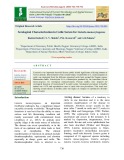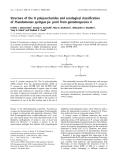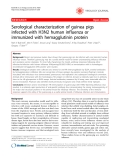
Serological characterization
-
Listeriosis was important bacterial disease public health significance affecting human as well as animals. Determination of the seroprevalance of antibodies to L. monocytogenes in cattle was attempted from the different organized cattle farm around the Nagpur region, Maharashtra India. Listeriolysin O is a haemolysin produced by the bacterium listeria monocytogenes for serological characterization. Present studies were targeted for serological detection of listeriolysin O in cattle serum. Serological prevalence in healthy animal was 4.
 5p
5p  cothumenhmong5
cothumenhmong5
 17-05-2020
17-05-2020
 13
13
 1
1
 Download
Download
-
Strains ofPseudomonas syringaepv. porri are characterized by a number of pathovar-specific phenotypic and genomic characters and constitute a highly homogeneous group. Using monoclonal antibodies, they all were classified in a novelP. syringaeserogroup O9. The O polysaccharides (OPS) isolated from the lipopolysaccharides (LPS) of P. syringaepv.
 8p
8p  tumor12
tumor12
 20-04-2013
20-04-2013
 38
38
 3
3
 Download
Download
-
Tuyển tập báo cáo các nghiên cứu khoa học quốc tế ngành y học dành cho các bạn tham khảo đề tài: Serological characterization of guinea pigs infected with H3N2 human influenza or immunized with hemagglutinin protein
 11p
11p  dauphong3
dauphong3
 26-12-2011
26-12-2011
 42
42
 4
4
 Download
Download
-
Harrison's Internal Medicine Chapter 107. Transfusion Biology and Therapy Blood Group Antigens and Antibodies The study of red blood cell (RBC) antigens and antibodies forms the foundation of transfusion medicine. Serologic studies initially characterized these antigens, but now the molecular composition and structure of many are known. Antigens, either carbohydrate or protein, are assigned to a blood group system based on the structure and similarity of the determinant epitopes.
 5p
5p  thanhongan
thanhongan
 07-12-2010
07-12-2010
 103
103
 5
5
 Download
Download
-
Diagnostic Testing For intractable symptoms or an elusive diagnosis, selected diagnostic tests can direct clinical management. Electrolyte replenishment is indicated for hypokalemia or metabolic alkalosis. Detection of iron-deficiency anemia mandates a search for mucosal injury. Pancreaticobiliary disease is indicated by abnormal pancreatic enzymes or liver biochemistries, whereas endocrinologic, rheumatologic, or paraneoplastic etiologies are suggested by specific hormone or serologic testing.
 7p
7p  ongxaemnumber1
ongxaemnumber1
 29-11-2010
29-11-2010
 84
84
 3
3
 Download
Download
CHỦ ĐỀ BẠN MUỐN TÌM


















